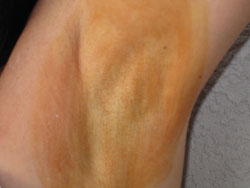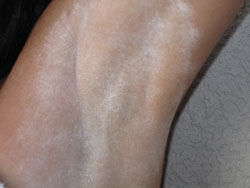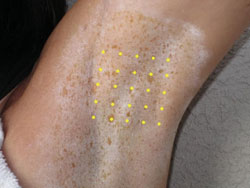Surgeons may want to consider expanded uses of botulinum toxin type A
Botulinum toxin type A can be used to manage hyperhidrosis.
Click Here to Manage Email Alerts
 Thomas John |
There has been a trend toward expanding the scope of clinical practice among some oculoplastic specialists to treat larger areas of their patients’ faces, including cosmetic facial plastic procedures such as endoscopic facial and eyebrow lifts, laser facial resurfacing, chemical peels, mid-facial surgery that is focused on the complex called the sub-orbicularis oculi fat pad, endoscopic approach via the nose to establish an anastomosis with the lacrimal sac for lacrimal drainage, intranasal ethmoidectomy, and other procedures. Another area of interest is the expanding use of botulinum toxin type A.
In this column, Drs. Small and Slonim describe their technique of using botulinum toxin type A to treat hyperhidrosis.
Thomas John, MD
OSN Surgical Maneuvers Editor
Hyperhidrosis is a condition of excessive sweating. It can be generalized, occurring throughout the entire body, or be localized to a particular region. Most commonly, this condition manifests on the palms of the hands, soles of the feet or axilla. More rarely, the face can be the primary region affected. In patients with hyperhidrosis, as in physiologic sweating, the eccrine sweat glands are stimulated by the sympathetic nervous system to release their contents. This process can be idiopathic or a manifestation of a systemic illness. This same neural pathway can be stimulated by metabolic disorders including hyperthyroidism and diabetes mellitus, neurologic disorders and malignancies to cause excessive sweating. Medications such as propranolol, pilocarpine and tricyclic antidepressants can also affect a component of the thermoregulation pathway to induce hyperhidrosis.
Therapies for hyperhidrosis include oral agents, topical agents and iontophoresis. Anticholinergic agents antagonize the effect of acetylcholine, which stimulates eccrine glands to release sweat. These are available in both oral (oxybutynin) and topical (glycopyrrolate 0.5%) preparations. Another agent, Drysol (20% aluminum chloride hexahydrate), can be applied topically to the affected areas, particularly when the disorder primarily affects the axillary region. Iontophoresis consists of passing a direct electrical current across the skin with either tap water or anticholinergic agents.
Botox (botulinum toxin type A, Allergan) injections have been shown to be effective in the management of hyperhidrosis. Its mechanism of action involves inhibiting the ability of the presynaptic neuron to release neurotransmitters, specifically acetylcholine. As a result, the eccrine glands are deprived of their neural stimulus to release their contents, and sweating is decreased.
The areas of hyperhidrosis should be identified and documented before any treatment. A simple technique to isolate these areas requires Betadine solution, cornstarch or fine talc powder, a handheld spotlight with a 100-watt bulb and a camera for documentation purposes.
The technique
First, paint the area of hyperhidrosis with the Betadine solution (a Betadine wipe will do) and allow it to dry completely (Figure 1). Next, sprinkle a thin layer of cornstarch or fine talc powder over the Betadine so that the brown color is completely covered by the white powder (Figure 2). Next, shine a handheld spotlight with a 100-watt bulb directly on the area to be treated. The warmth of the bulb will stimulate the areas affected by hyperhidrosis. The moisture will cause the Betadine to bleed through the white powder or cornstarch (Figure 3). Next, photograph the area for documentation.
 Figure 1. Betadine is applied to the axillary region. |
 Figure 2. A thin layer of talc or cornstarch is applied, completely covering the Betadine. Images: Slonim CB, Small
L |
 Figure 3. A 100-watt light bulb causes sweating to ensue, causing the Betadine to bleed through. |
 Figure 4. Botulinum toxin type A is injected into the targeted area in a grid pattern with approximately 1 cm between injections. |
Because of the number of required injections, the use of a topical anesthetic is highly suggested. Apply a thin layer of topical anesthetic cream, such as EMLA or Betacaine. After applying to the axillae, have the patient keep their arms against their sides for at least 20 minutes. Next, wipe the topical anesthetic away. Inject the botulinum toxin type A into the dermis in a grid pattern (eg, 4 × 4, 5 × 5) with approximately 1 cm between injections (Figure 4).
The amount and concentration of botulinum toxin type A injected should be 2.5 units per 0.05 cc per injection site. This is created by adding 2 cc of preserved saline (less stinging than unpreserved saline) in one vial (100 units) of botulinum toxin type A. This will yield approximately 40 injections. The duration of effect of this treatment varies from approximately 3 to 6 months and, rarely, up to a year before needing to be repeated. The mechanism for the increased duration of effect beyond the typical duration of action of botulinum toxin type A is unknown. A slow recovery of a sweat gland that has been idle for a number of months may be one possible explanation.
References:
- Callejas MA, Grimalt R, Cladellas E. Hyperhidrosis update. Actas Dermosifiliogr. 2010;101(2):110-118.
- Grunfeld A, Murray CA, Solish N. Botulinum toxin for hyperhidrosis: a review. Am J Clin Dermatol. 2009;10(2):87-102.
- Lowe NJ, Glaser DA, Eadie N, Daggett S, Kowalski JW, Lai PY; North American Botox in Primary Axillary Hyperhidrosis Clinical Study Group. Botulinum toxin type A in the treatment of primary axillary hyperhidrosis: a 52-week multicenter double-blind, randomized, placebo-controlled study of efficacy and safety. J Am Acad Dermatol. 2007;56(4):604-611.
- Thomas John, MD, is a clinical associate professor at Loyola University at Chicago and is in private practice in Oak Brook, Tinley Park and Oak Lawn, Ill. He can be reached at 708-429-2223; fax: 708-429-2226; e-mail: tjcornea@gmail.com.
- Charles B. Slonim, MD, FACS, can be reached at USF Eye Institute, 13127 Magnolia Drive, Tampa FL 33612; 813-974-2064; fax: 813-974-5621; e-mail: cslonim@health.usf.edu.
- Laurie Small, MD, can be reached at lsmall2@health.usf.edu.

